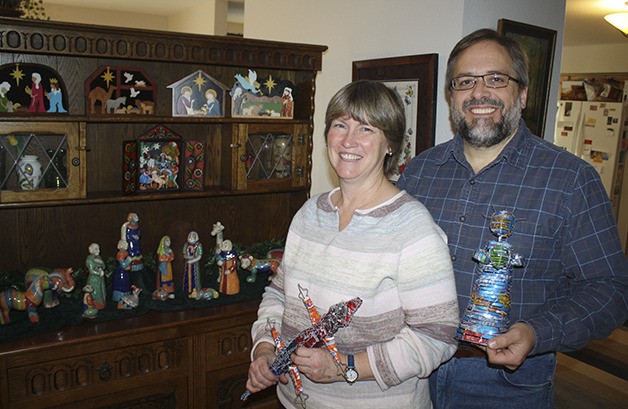It’s not your typical nativity set.
Brightly colored strips of aluminum—former Fanta, Coke and fruit juice cans—coalesce into a wiry-haired Mary, Joseph, Jesus, wise men and a crocodile. As nativity scenes go, it’s metallic, and hardly cute. This one is not exactly Diane Garding’s favorite.
But she’s bringing it, as she does every year, to the Bellevue Festival of the Nativity, along with 89 other nativity sets she’s collected from around the world.
Diane’s 90 sets, part of more than 500 nativities on display through December 14 at the Bellevue Church of Jesus Christ of Latter Day Saints.
She and her husband Phil, who live in North Bend, are by far the largest contributors of nativities at the annual festival. At home, they’ve collected more than 300 over the past 25 years.
Telling a story
The recycled-can nativity is an audience favorite, says Phil, because it’s so different. It was made in South Africa by young war refugees from Zimbabwe, trying to earn enough money to one day go back home.
The one time she didn’t take to Bellevue, Diane said, she was asked, “Can you please bring it next year and every year?”
Like many in Diane and Phil’s collection, it was made by individuals, comes from far away, and has meaning.
The Gardings prefer to collect handmade sets from different places, and like to support the crafters who make them.
It’s hard for Diane and Phil to pick a favorite set. That’s because so many have their own story.
Their first was a German nativity they found in Seattle’s Pioneer Square, in 1989, the year they moved to Washington. They started collecting a few pieces at a time, and their hobby developed from there.
Diane mainly travels the Internet to make her finds, but some international travels have made for new nativity stories. Pointing out a carved, ebony set, Diane explains, “Phil and I have made a couple trips to Kenya to do humanitarian aid with the Imani Project,” an organization that combats AIDS and improves health conditions in rural parts of that country. “When we were in Malindi, Kenya, we went to the market, and there was a fellow that did beautiful Masai carvings.” The man, whose name is James, mailed that first set, the nativity as seen through the lens of the Masai people, and they struck up a relationship. He’s since made other sets for them.
Many nations are represented in the Garding’s collection: The Czech Republic, Tanzania, Mexico, Argentina, and Cameroon.
They have nativities made of thornwood from Nigeria, woven horsehair from Chile, recycled snack bags from Honduras. One African craftsman made his nativity set out of bullet casings, collecting the spent rounds, cutting and shaping them.
“He was using it to turn bad into good,” Diane said.
They’ve collected a handful of commercially-produced sets, such as one large, sculptural set from Italy that Diane found as a bargain online. But mostly, these are handmade and unusual.
“We like whimsical stuff more than traditional,” Diane said.
The collection is a matter of faith for the Gardings. It also explores human expression.
“For a number of people who make these, it’s a gift of their heart,” Diane said. “It’s their expression of love for the savior. And I love seeing how people do that, because it’s all very different.”
This year, for the Bellevue festival, she chose 90 of her nativities that represents different media—carved or painted wood, natural and recycled materials, metal, stone.
“People love to see them,” said Phil. “They’re fascinated to see all the different ways that people express the birth of the savior.”
The Bellevue Festival of the Nativity is 12:30 to 9 p.m. Friday, Saturday and Sunday, Dec. 12, 13 and 14, at the Church of Jesus Christ of Latter Day Saints, 15205 S.E. 28th St., Bellevue. Admission is free. Learn more at www.bellevuenativity.com.

The Gardings select handmade crafts with stories to tell, such as a Zimbabwe nativity made from recycled Ak-47 bullet casings.

This nativity piece, made of woven horsehair and made in Chile, sits in Diane Garding’s hand.


